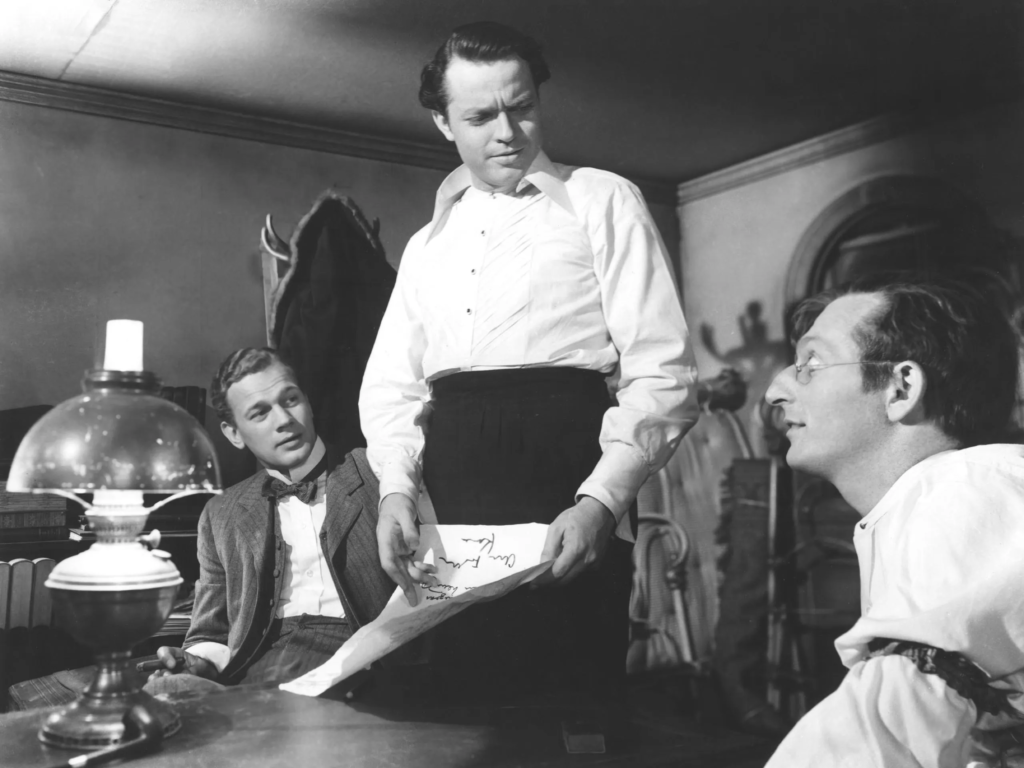Task 1
‘Explain how the production context of Citizen Kane influenced the ‘look and feel’ of the end product.
To begin, Orson Welles was unusually given large autonomy when it came to directing Citizen Kane, and RKO in doing so allowed more a more experimental film.

This relative freedom given to Welles by RKO allowed for experimental shots: for example low angles that showcased the power dynamic of characters, that required equipment that would more commonly be hidden on ceilings to be hidden due to the visibility of the ceiling overhead.
Task 2:
Choose your favourite scene in the Film and why this is the case.

My favourite scene from Citizen Kane is where Jerry Thompson goes to look at Mr Bernstein’s Archives to find any memoirs about Kane.
This is because of the intense chiaroscuro lighting used, as well as the silhouettes of characters inferring their mystery or perhaps Kane’s mystery. The shot is structured in a way that makes it almost symmetrical, and plays into a theme of power and organisation.
As well, Welles’ use of moving the camera into the room through a large vault door adds to the intrigue of the scene- and pits the viewer into believe they are getting insight into a very secret chamber.
Task 3: Why do you think Citizen Kane is cited by many critics as the ‘best film of all time’?
Pre-Citizen Kane cinema was very static. There were the odd tracking shots, and extreme angles; but innovation in Cinema prior focused more on Mise-en-scene, plot and technology. Orson Welles’ approach to Citizen Kane was to reinvent the techniques of cinematography: in shot angles & staging, lighting as well as tracking & deep focus.

Shot angles & staging became a technique to represent the relationships and dynamics between characters. It is used often throughout Citizen Kane, and the shot shown from the scene where Kane is sent off as a child; it shows the division between the Mother and Father, whilst highlighting the relative neglect Kane, (seen in the back), is experiencing as a child. Throughout the film, this technique is used again & again, especially to highlight Kane’s power and ambition in comparison to other characters.

Lighting is used in Citizen Kane in order to imply emotion & intrigue onto characters. Take the shot above of Mrs Kane, where the chiaroscuro of the light hitting half her face in contrast to the shadow of Kane on the other. This shows inner-conflict on Mrs Kane’s behalf, and highlights the power Kane has as well. Repeatedly, Welles’ uses lighting to imply meanings, rather than just writing down his intentions in a script- a technique used widely in cinema today, but revolutionary for its time.

Lastly, I have grouped tracking & deep focus as one, due to the fact that Welles pairs these two shot types often. He does this most strikingly in the ‘Archives’ scene, where the vault door opens & the camera moves into a dark room looking straight down to the opposite wall. These two shot types are used throughout Citizen Kane to impose grandeur & importance to buildings & people.
Overall, it is clear to see that the use of shot angle & staging, lighting, tracking & deep focus helped Citizen Kane become a success and be labelled ‘The Greatest Movie ever Made’, due to its influence on the wider cinematographic world. Here, cinematography is secondary only to dialogue in furthering plot, and this is shared by most movies post 1941 due to the films influence on cinema as part of its success.